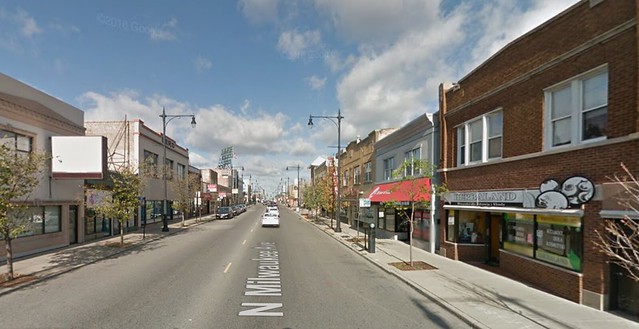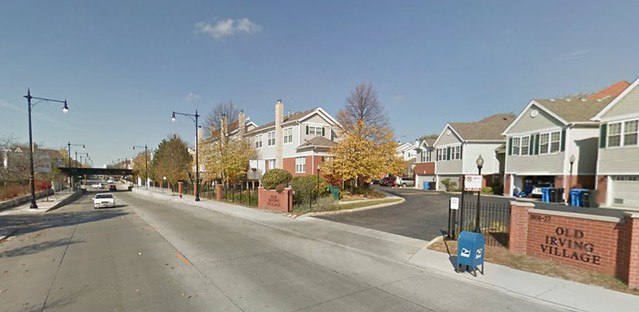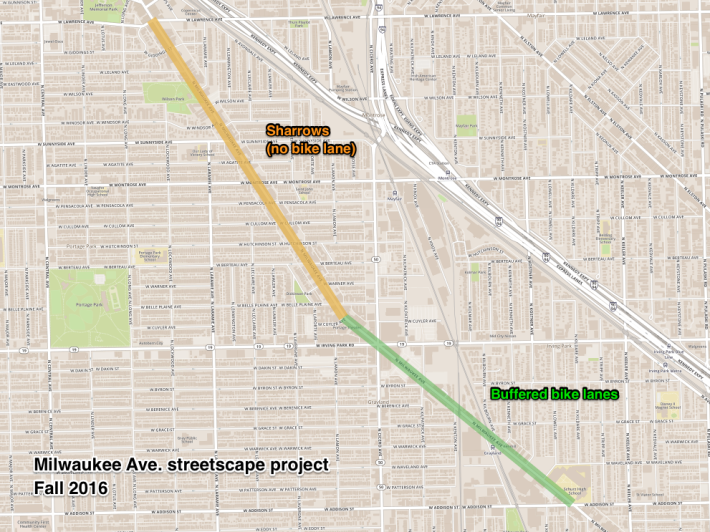
Milwaukee Avenue is Chicago’s busiest biking street, with as many as 5,000 bike trips a day during the high season, according to the Chicago Department of Transportation, with most of that cycling taking place between Logan Square and the Loop. But the Blue Line corridor is becoming an increasingly popular place to live, and we’re seeing transit-oriented development proposals in neighborhoods like Avondale, Portage Park, Old Irving Park, and Jefferson Park. As more car-free and car-lite residents settle further northwest along Milwaukee, bike traffic is going to increase on stretches of the road that are farther from the Loop.
So it’s great that the 45th Ward Alderman John Arena recently announced the ward is teaming up with CDOT to install bikeways along Milwaukee between Addison Street and Lawrence Avenue – a two-mile stretch. On the shorter section between Addison and Irving Park Road, Arena and CDOT aren’t letting narrow right-of-way stop them from improving safety. Ninety-two little-used parking spaces will be stripped from the east side of Milwaukee on this stretch to make room for buffered bike lanes, which help provide extra breathing room for people biking.
Unfortunately, however, there will be no major improvements to the longer segment of Milwaukee between Irving and Lawrence. The city won’t be moving any parking from this segment, so there will only be room for "sharrows," the bike-and-chevron road markings that have been shown to have relatively little effect on improving bike safety.
45th Ward residents voted for the bike lanes project as the top priority in the ward’s May 2015 participatory budgeting election, so the facilities will be bankrolled with $100,000 from the district’s $1.3 million discretionary budget for that year. Work on the bikeways should start later this year, DNAinfo reported.

Since Milwaukee between Addison and Irving doesn’t have enough right-of-way for parking on both sides, travel lanes and buffered bike lanes, CDOT recently did eight parking studies on this stretch to see how many spaces were actually being used. The department found that, since this segment has little retail, and much of the housing has off-street parking, curbside spaces were seeing little use. In addition, the absence of metered parking makes it relatively easy to strip parking.
The project also with involve the removal or relocation of several stops for the #56 Milwaukee bus between Addison and Irving, DNA reported. The city says this will shorten travel times and enhance safety.
The higher density of retail between Irving and Lawrence combine with less off-street parking for residences, and the resulting higher parking demand, made removing dozens of parking spaces on that stretch a non-starter, Arena said.
Notably, this stretch is just south of a four-lane stretch of Milwaukee north of Lawrence where CDOT previously proposed converting two of the lanes to protected bike lanes, which would have required the removal of a few parking spots for sight lines. After a major backlash from residents, the road diet idea was scrapped and the department installed buffered lanes instead – a much more modest safety improvement.
Another issue with removing parking between Irving and Lawrence is the city’s despised parking meter deal. The presence of metered spaces on this stretch would make parking removal much more complex because the city would either have to replace these spots with new metered spaces elsewhere in the area, or compensate the parking concessionaire for lost revenue.
Thus the neighborhood is getting "sharrows," which have some value for wayfinding, reminding people in cars to watch out for people biking, and helping keep cyclists out of the way of parked car doors, but are otherwise useless for separating motorized traffic from bike traffic. That means bike riders who pass through or patronize this retail strip will see limited benefits.
While the decision to water down bike improvements on this stretch is understandable, it’s a little frustrating. But if bike lanes are a no-go on this stretch, what else could the city do to improve safety for people biking?
Improving the massive Milwaukee/Irving/Cicero intersection, aka Six Corners, is an obvious option. CDOT should definitely stripe the Milwaukee bike lanes through the junction. And perhaps in the future the intersection could be made more people-friendly through the addition of curb extensions to shorten pedestrian crossing distances and calm traffic. This strategy is already planned for the similarly intimidating intersection of Lincoln Avenue, Belmont Avenue, and Ashland Avenue in Lakeview.
Adding Dutch-style protected intersection treatments at key street crossings along Milwaukee – especially on the section with "sharrows" – would be another solution. CDOT has already dabbled with this concept downtown, although they haven’t built a proper protected intersection yet.
Another idea that might be a little tricky politically, but well worth it, in terms of reducing crashes and promoting a better walking and shopping environment on Milwaukee would be to lower the speed limit from the city’s default 30 m.p.h limit. Sure, some car commuters would grumble, but we have to choose – do we want Milwaukee to be a throughfare for motorists to pass through quickly, or do we want to make it a safer, more pleasant, and more prosperous street on which to live and shop?
This post is made possible by a grant from the Illinois Bicycle Lawyers at Keating Law Offices, P.C., a Chicago, Illinois law firm committed to representing pedestrians and cyclists. The content is Streetsblog Chicago's own, and Keating Law Offices neither endorses the content nor exercises any editorial control.






